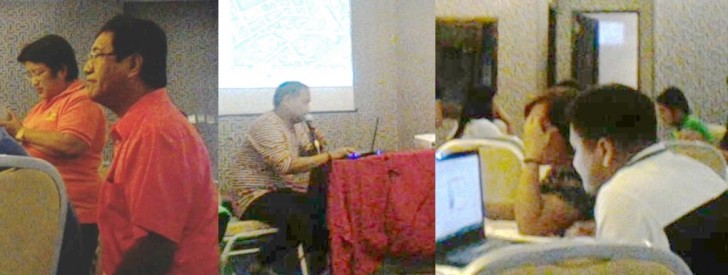 Participants to the Applied Geo-tagging Technology, young and old alike, take step by step instructions from (top photo)Mr. Christian Patrick L. Mones, PSO Luzon A Representative for GGU, using their own geo-tagging capable gadgets.
Participants to the Applied Geo-tagging Technology, young and old alike, take step by step instructions from (top photo)Mr. Christian Patrick L. Mones, PSO Luzon A Representative for GGU, using their own geo-tagging capable gadgets. NPCO, PSO Luzon A, and RPCO2 conduct simultaneous trainings on Geo-tagging and GRM
A simultaneous two-day training workshop each on Applied Geo-tagging Technology and Setting up of Grievance Redress Mechanism (GRM) were attended to by participants from the Provincial Project Monitoring and Implementation Units (PPMIUs) of Batanes and Cagayan.
The training workshops dubbed as “two in one” was conceived by the Regional Project Coordination Office (RPCO2) to maximize the presence of participants from Batanes whose participation has always been under mercy from the weather condition and availability of ride either by land or air.
“Let us take the most of the learning that we can get from the training workshops!”
Thus said Dr. Geronima S. Ludan, RPCO 02 Social and Environmental Safeguards (SES) Unit Head, on day 1-October 13 opening program at the Emerald Hall in Zen Hotel, Santiago City, Isabela and closing on day 4 -October 16, 2015.
Apart from the theoretical aspects on geo-tagging technology like the tools for geo-tagging, enhancing project management through GPS technology, geo-tagging programmes for Rural Infra Sub-projects, data gathering/documenting a project through geo-tagging, and processing geo-tagged images, the participants had a hands-on application of the technology simulating a sub-project geo-tagging from the venue to Barangay Rizal in Santiago City.
Mr. Christian Patrick Mones, PSO Luzon A Representative for Geotagging and Governance Unit (GGU), had patiently guided each participant how to install, use and explore the geo-tagging tools to make sure that each one can cope up with the technical aspects of the technology.
“It took me some time to be able to assimilate and apply what I am sharing you right now,” Mr. Mones said adding that he understands the intricacies of geo-tagging technology; hence, it cannot be imbibed in one sitting.
Historically, the geo-tagging technology is developed under the Mindanao Rural Development Program 2 (MRDP2) in 2011 as an innovative and cost-efficient ICT application, which associates digital resource such as photos and videos with geographic and location information with high degree precision.
It is Google Earth-based tool, facilitating easy and accurate locations of infrastructure, livelihood and agri-fishery facilities on a map enabling virtual monitoring and supervision of sub-project implementation. Compilations of these geo-tagged sequences create a web-based mapping system that depicts the overall development impact of agricultural intervention.
“The technology aside from other advantages,” Mones emphasized, “can show when an overlapping of previously funded road network projects are again on deck for the same request. It is then a tool to minimize if not to totally do away with corruption.”
Meanwhile, the same set of participants took part in the “Setting Up of Grievance Redress Mechanism” seminar aimed at orienting them of the Philippine Rural Development Project’s (PRDP) Grievance Redress Mechanism Design and Principles, Roles and Responsibilities of PRDP Grievance Point Persons (GPPs), PRDP requirement for local government units (LGUs), Grievance Resolution Process, as well as the filling out of electronic templates forms sourced from the PRDP website.
Dr. Freddie B. Corsino, RPCO2 Action Officer and InfoACE Unit Head briefed participants on the latest updates on PRDP subprojects status of implementation within the PSO Luzon A Cluster to have a clearer picture on what the PRDP is all about.
Resource speakers Michael Francis Falconi, Environmental Safeguards Officer from the National Project Coordination Office (NPCO), SES Specialist Enika Hernando and PSO Environmental Safeguards Specialist Emmanuel C. Aragones, at most did actual applications of the principles behind the PRDP SES and GRM elements to accustom participants on what they shall be doing back home in their respective offices and in the field.
Meanwhile, Ms. Ma. Lourdes C. Corsino, RPCO2 SES Officer and GRM Point Person, took note of PPMIU Batanes’ SES/GRM issues and concerns raised which finds peculiar applicability under PRDP being considered a “protected area “as a whole.
“I suggest,” Ms Corsino said,” that such issues might as well be written as a” position paper” emanating from PPMIU Batanes coursed through the PRDP up lines which is a very good point of discussion the settlement of which will serve as a landmark reference for similar circumstances on SES concerns in the near future.” (Ferdinand C. Narciso, RPCO2 InfoACE)
